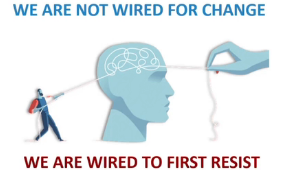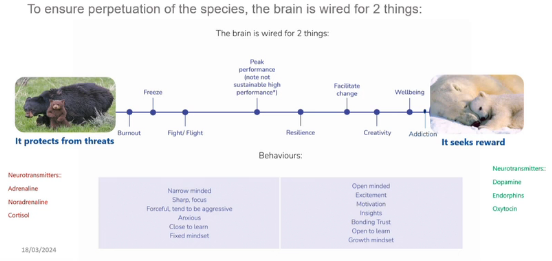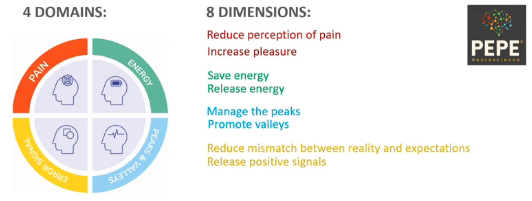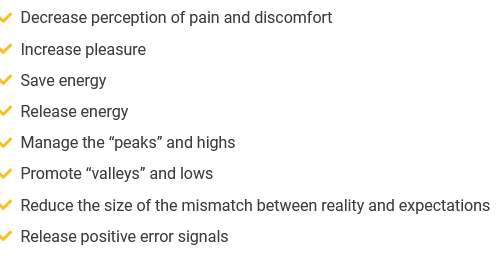Framework 176 PEPE (a neuroscience approach)
Introduction
You need to understand the brain's response to change. For example:
- how the brain processes information, makes decisions, etc
- how to tailor communications, engagement, etc strategies that resonate with neural pathways
- how to mitigate the perception of pain associated change
- how to enhance engagement through strategic releases of dopamine, endophins and oxytocin
- hhow to achieve the right balance between threat and reward systems
- why the brain tends to initially resist change, etc
(for more detail, see elsewhere in the Knowledge Base)
Even though each brain is unique, there are common characteristics of all brains .
To create habits that support positive adaptation to change by the brain
To creating a culture of change, you need to develop the appropriate habits (an automatic process) that is brain-friendly. To create these habits by:
i) avoiding cynicism (create a contagious culture of change to handle cynicism; it can start with a few people and spread)
ii) increasing motivation
iii) increasing engagement
iv) increased active resilience (more than bouncing back, it is bouncing forward)
NB The brain prefers the status quo. This state is how it has built up its strongest neural connections and any change is initially seen by the brain as a threat to the status quo and thus resisted, especially as it will require a lot of energy to build new neural connections.

(source: Tibisay, Vera, 2024)
NB
"...we 'humans' and our 'human brains' are not wired - in terms of biological or phycological processes- for change. Instead, we are wired to first resist and remain in the status quo..."
Tibisay, Vera, 2024a
However, the brain will adapt to change as
"...brain plasticity is the ability of the brain to continuously adapt in functional and structural ways......to changing requirements..."
Tibisay, Vera, 2024
Despite our initial resistance, our brains will adapt to change.
However, there can be a high cost to this adaptation, eg the brain could mal-function. This is called 'mal-adaptive plasticity' which can be shown by
"...- Lack of motivation: no engagement, poor performance, lower productivity
- Cynicism: in all the formats, high turnover, lack of change sponsors, no trust
- Compromised well-being: chronic stress, burnout, anxiety, chronic pain
- Addiction..."
Tibisay, Vera, 2024
Organisation need to encourage a positive attitude to change.
NB The main role of the brain is to ensure the survival of the species; this is achieved by protecting from threats and seeking rewards. However, current threats and rewards are different from those our ancestors faced in the caves and on the savannah grasslands; Today, change is seen as a major threat with its uncertainty and frequency.
To get engagement and facilitate change, you need to achieve high performance and well-being plus the right balance between threats and rewards needs to be found.
NB The brain is more likely to react more positively to personalised, unique activities than to vague concepts like visions, etc.
Another way of looking at this

(source: Tibisay Vera, 2024)
Certain chemicals, eg neurotransmitters, are released in response to threats and rewards.
- Under threats (potential and/or actual) the brain releases adrenaline, noradrenaline and cortisol to provide the energy and focus needed to handle the threat; these chemicals work best in short bursts to handle an immediate threat, ie once the threat has passed, these chemicals dissipate.
As change is seen initially as a threat as it creates uncertainty for the brain, there will be a release of adrenaline, noradrenaline and cortisol.
- in response to rewards, dopamine, endophins and oxytocin are released; these will make us feel motivated, increase bonding and trust, reduce the pain of change, encourage creativity and insights, favours a growth mindset, etc. Release of dopamine, endophins and oxytocin are needed to encourage and facilitate a positive approach to change.
There are 4 main brain responses or domains to change:

(source: Tibisay, Vera, 2024)
You will always feel uncomfortable and experience some pain when confronted with change, even if it is a positive change with many benefits. This pain will make you want to resist change.
In dealing with the pain, the brain will use energy; the brain can be very demanding on energy consumption. However, as the brain is 2% of the body weight and uses 20%+ of the body's energy, it will always try to conserve and save energy. Thus to do this, the brain will want to resist energy-expensive change activities like encouraging buy-in, doing things differently, etc.
Change requires the development of new neural pathways in the brain, to handle the change, such as new information; this is a very energy-expensive process.
The brain's daily energy levels fluctuate, with a peak in the morning; as a day continues, the energy levels fall; however, with constant change requiring continuous all-day high levels of energy it doesn't allow the brain time to recharge its energy levels, ie valleys.
"...the fast speed that change occurs in modern life and the continuous and constant change that organisations currently are facing, narrows the possibility of a healthy fluctuation in the chemistry and waves of our brain..."
Tibisay, Vera, 2024a
Furthermore,
"...the human brain seems to be wired to function well under short cycles of high and low levels of neurotransmitters and hormones, such as cortisol, adrenaline, noradrenaline, dopamine, endorphins and others as it helps us to adapt, engage, build resilience and increased well-being..."
Tibisay, Vera, 2024a
If you provide too much information, the brain will use energy sorted the information out; however, if provided with too little information, the brain will expend energy as it feels stressed trying to find more information; the brain needs to be provided the right amount of information at the right time.
NB The default position of the brain is to assume the worst scenario, ie errors signal; need to manage negative expectations. the higher the error signal, the greater the pain experienced and the cycle repeats itself, ie pain, energy, fluctuations, errors signal, etc.
The human brain is at an 'anticipation machine'
"...change and uncertainty challenges individual abilities of using previous experience to predict the future and this ability is directly related to our level of certainty regarding future events, making the brain release strong error signals, which can be negative or positive depending on how we manage them..."
Tibisay, Vera, 2024
PEPE framework
It involves the 4 domains; with each domain having 2 dimensions:

(source: Tibisay, Vera, 2024)
You can increase the pleasure by reducing perception of pain and/or by encouraging the release of pleasure neurotransmitters, like dopamine, endophins and oxytocin.
A similar situation with energy, ie find ways to save it so it is then available for release when needed in the change process, eg dopamine can provide a lot of energy.
Implement strategies to release more dopamine like creating positive anticipation about the change, which will generate excitement, interest and engagement.
Promote the valleys by encouraging reflection.
Use positive signals to reduce the mis-match between reality and expectation, eg pattern recognition; familiarity; chunking large tasks into a series of smaller, manageable tasks; evolutionary (small) rather than revolutionary (large) change, etc; this will also reduce cynicism.
Using a heat map to show where different stakeholders are positioned in the PEPE framework and then develop strategies to handle:

(source: Tibisay, Vera, 2024)
For example, stakeholder 2 is feeling little pain and much pleasure, so energy levels are high and need releasing and is good at reflection; stakeholder 3 is feeling little pain and needs a lot of energy to manage the peaks and to handle the valleys.
Summary

(source: Tibisay, Vera, 2024)
The 8 dimensions for managing change

(source: Tibisay, Vera, 2024)
NB
"...the intention of PEPE neuroscience is to provide a systematic brain-friendly approach to a very pragmatic and simple way to support engagement, motivation and well-being during changing times.
Labelling and understanding these drivers raises conscious awareness to an otherwise non-conscious process. Intervention can be made in very practical ways by stakeholders and leaders of the organisation by creating habits that support each of the eight dimensions depending on what is needed to support the change..."
Tibisay, Vera, 2024
"...it is all about 'hacking or tricking our brain' to move faster from the shock and resistance phase of change to the acceptance and engagement phase to avoid change fatigue and increase the level of well-being..."
Tibisay, Vera, 2024a
